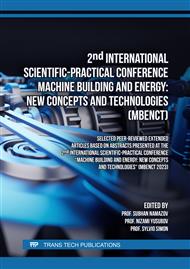[1]
Baek Sangkyu, Choi Bong Dae. Performance analysis of power save mode in IEEE 802.11 infrastructure WLA.2008 International Conference on Telecommunications.IEEE. (2008) 1– 4.
DOI: 10.1109/ictel.2008.4652710
Google Scholar
[2]
Ibrahimov Bayram. Method for calculation indicators steganographic systems in multiservice communication networks. International Robotics & Automation Journal. 9 (2023) 40 - 43.
DOI: 10.15406/iratj.2023.09.00261
Google Scholar
[3]
Chen Qinghua. An energy efficient channel access with target wake time scheduling for overlapping 802.11 ax basic service sets. IEEE Internet of Things Journal. 9, 19 (2022) 18973 –18986.
DOI: 10.1109/jiot.2022.3163339
Google Scholar
[4]
E.Guerin, T.Begin, I.Lassous. An overview of MAC energy-saving mechanisms in Wi-Fi. Computer Communications. 203, (2023) 129 –145.
DOI: 10.1016/j.comcom.2023.03.003
Google Scholar
[5]
A.Rustamov, M.Binnetov, K.Gurbanov. Ensuring reliability in upgrading and maintaining special-purpose radioelectronic equipment. Vasil levski national military university security and defense scientific journal year, II Issue 2, 2023. pp.1-7.
Google Scholar
[6]
E.Viciana, A.Alcayde, F.G. Montoya, R.Banos, F.M. Arrabal-Campos, Manzano F.Agugliaro. An Open Hardware Design for Internet of Things Power Quality and Energy Saving Solutions. Sensors. 19 (2019) 627.
DOI: 10.3390/s19030627
Google Scholar
[7]
V.A. Tikhvinsky, S.V. Terentyev, V.A. Koval, E.E. Devyatkin. Development mobile communication networks from 5G Advanced to 6G: projects, technologies, architecture. M.: Technosphere, (2023).
Google Scholar
[8]
B.G. Ibrаhimov, M.B. Namazov, M.N. Quliev. Analysis performance indicators network multiservice infrastructure using innovative technologies. Proceedings of the 7-th International Conference on Control and Optimization with Industrial Applications. II. (2020) 176-178.
Google Scholar
[9]
A.Rustamov, K.Gurbanov, V. Katexliyev. Calculation of the destruction effectiveness of military ships' fire means according to the impact distance. National Security and Military Sciences, 3(9), 2023, pp.44-50.
Google Scholar
[10]
S.Andrade E Ruiz, E.Granell, J.Lloret. Energy Consumption of Wireless Network Access Point. In Green Communication and Networking, Proceedings of the 2nd International Conference, GreeNets 2012, Gandia, Spain, October 25–26, 2012, Springer: Berlin/Heidelberg, Germany, 2012, p.81–91.
Google Scholar
[11]
O.I. Shelukhin. Modeling of information systems. Textbook for universities.-M.: Hotline – Telecom. (2018).
Google Scholar
[12]
A. Lyakhov, V. Vishnevsky, M. Yakimov. Multicast QoS support in IEEE 802.16. Proceedings of the Third ACM International Workshop on QoS and Security for Wireless and Mobile Networks. Chania, Crete Island, Greece, Oct. 22, 2017. pp.63-70
DOI: 10.1145/1298239.1298251
Google Scholar



